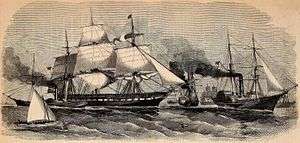Paraguay expedition
| Paraguay Expedition | |||||||
|---|---|---|---|---|---|---|---|
 The Paraguay Squadron (Harper's Weekly, New York, October 16, 1858). | |||||||
| |||||||
| Belligerents | |||||||
|
|
| ||||||
| Commanders and leaders | |||||||
|
|
| ||||||
| Casualties and losses | |||||||
| None | None | ||||||
The Paraguay Expedition was a United States Naval mission sent to Asunción, Paraguay, in 1858 to demand indemnity and apology from the Paraguayan Government for the 1 February 1855 firing on the U.S. Navy vessel USS Water Witch and for alleged insults against the United States and Paraguay Navigation Company. This was an example of U.S. gunboat diplomacy. Carlos Antonio López agreed to indemnify the families of the crew and the Supreme Court of the United States declared the innocence of the Paraguayan Government in the incidents.
The Incident
.jpg)
In 1858, the U.S. Congress authorized a Naval Squadron to be sent to Paraguay to seek redress from Paraguay for the shelling of the Water Witch in 1855, which had resulted in the death of the ship's helmsman. President James Buchanan appointed James B. Bowlin, a former Missouri congressman, as the American commissioner to conduct the negotiations.
To lend credibility and force to Bowlin's demands, Buchanan ordered the Navy to establish a force which could compel compliance. However, only a couple of sailing ships were then assigned to the Brazil Squadron, and few light-draft, naval steamers were available elsewhere. To meet the needs of the expedition, the Navy chartered seven steam-propelled merchant ships. The Sabine, which conveyed Commissioner Bowlin to Buenos Aires, was not considered part of the expedition fleet, as she was not designed to act against Paraguay, not being able to ascend the river.[1]
The expedition was led by Flag Officer William B. Shubrick. The task force departed New York City on 17 October 1858; but, for the most part, its 19 ships proceeded southward independently. The ships of the expedition formed up at Montevideo, Uruguay. The slowest ship, USS M. W. Chapin, arrived on 29 December. All but two vessels of Shubrick's fleet got underway from Montevideo on 30 December and ascended the Río de la Plata, the Paraná, and the Paraguay rivers. Upon reaching Rosario, Water Witch and Fulton left their companions behind and continued on to Asunción with Bowlin and Shubrick. They arrived off Asunción on 25 January 1859.
Bowlin went ashore to conduct negotiations with Paraguayan president Carlos Antonio López, which were completed in a fortnight. As a result of the expedition, Paraguay extended an apology to the United States, indemnified the family of the slain Water Witch crewman, and granted the United States a new and highly advantageous commercial treaty.[2]
Ships of the expedition
- USS Argentina
- USS Atlanta (subsequently USS Sumpter)
- USS Bainbridge
- USS M. W. Chapin (subsequently USS Anacostia and Alexandria)
- USS Dolphin
- USS Falmouth
- USS Fulton
- USRC Harriet Lane (subsequently USS Harriet Lane)
- USS Memphis (formerly Mount Savage; subsequently USS Mystic and General Custer)
- SS Caledonia (subsequently USS Mohawk and SS Alliance)
- USS Metacomet (subsequently USS Pulaski)
- USS Perry
- USS Release (formerly Eringol), supply ship
- USS St. Lawrence
- USS Sabine
- USS Southern Star (subsequently USS Crusader)
- USS Supply, supply ship
- USS Water Witch
- USS Western Port (formerly SS Western Port; subsequently USS Wyandotte)
References
- ↑ Expenses - Paraguay Expedition, House of Representatives, 36th Congress, 1st Session, Mis. Doc. No. 86 (May 11, 1860), p. 142
- ↑ On This Day spacer On April 30, 1859, Harper's Weekly featured a cartoon about a U.S. military expedition to Paraguay - http://www.nytimes.com/learning/general/onthisday/harp/0430.html
![]() This article incorporates public domain material from websites or documents of the Naval History & Heritage Command.
This article incorporates text from the public domain Dictionary of American Naval Fighting Ships.
This article incorporates public domain material from websites or documents of the Naval History & Heritage Command.
This article incorporates text from the public domain Dictionary of American Naval Fighting Ships.